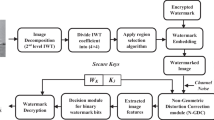Abstract
To study how to design a steganographic algorithm more efficiently, a new coding problem—steganographic codes (abbreviated stego-codes)—is presented in this paper. The stego-codes are defined over the field with q(q ≥ 2) elements. A method of constructing linear stego-codes is proposed by using the direct sum of vector subspaces. And the problem of linear stego-codes is converted to an algebraic problem by introducing the concept of the tth dimension of a vector space. Some bounds on the length of stego-codes are obtained, from which the maximum length embeddable (MLE) code arises. It is shown that there is a corresponding relation between MLE codes and perfect error-correcting codes. Furthermore the classification of all MLE codes and a lower bound on the number of binary MLE codes are obtained based on the corresponding results on perfect codes. Finally hiding redundancy is defined to value the performance of stego-codes.
Similar content being viewed by others
References
Crandall R.: Some notes on steganography. Available: http://os.inf.tu-dresden.de/~westfeld/crandall.pdf (1998). Accessed August 2007
Fridrich J., Goljan M. (2004). On estimation of secret message length in LSB steganography in spatial domain. Proceedings of SPIE-Security. Steganography and Watermarking of Multimedia Contents VI 5306, 23–34
Fridrich J., Goljan M., Soukal D.: Searching for the stego key. In: Proceedings of SPIE-Security, Steganography and Watermarking of Multimedia Contents VI, Electronic Imaging 5306, 70–82 (2004).
Chen Y.Y., Pan H.K., Tseng Y.C.: A secure data hiding scheme for two color images. In IEEE Symposium On Computer and Communications (2000) Available: http://www.csie.nctu.edu.tw/yctseng. Accessed May 2005
Tseng Y.C., Pan H.K. (2002). Data hiding in 2-color images. IEEE Trans. Comput. 51(7): 873–890
Westfeld A.: F5: a steganographic algorithm, high capacity despite better steganalysis. Proceedings of 4th International Workshop on Information Hiding. LNCS 2137, 289–302 (2001).
MacWilliams F.J., Sloane N.J.A. (1977) The theory ofÿ Error-Correcting Codes. North-Holland Publishing Company, Amsterdam
Tietäväinen A. (1973). On the nonexistence of perfect codes over finite fields. SIAM J. Appl. Math. 24: 88–96
Krotov D.S. (2000). Lower bounds on the number of m-quasigroups of order 4 and the number of perfect binary codes. Discrete Anal. Oper. Res. 1(7) 2: 47–53
Moulin P., O’Sullivan J.A. (2003). Information theoretic analysis of information hiding. IEEE Trans. Inform Theory, 49(3): 563–593
Moulin P., Wang Y.: New results on steganographic capacity. Proceeding of CISS 2004. University of Princeton, Princeton, New Jersey (2004). Available: http://www.ifp.uiuc.edu/~ywang11/paper/CISS04_204.pdf. Accessed August 2007
Author information
Authors and Affiliations
Corresponding author
Additional information
Communicated by P. Wild.
Rights and permissions
About this article
Cite this article
Zhang, W., Li, S. A coding problem in steganography. Des. Codes Cryptogr. 46, 67–81 (2008). https://doi.org/10.1007/s10623-007-9135-9
Received:
Revised:
Accepted:
Published:
Issue Date:
DOI: https://doi.org/10.1007/s10623-007-9135-9
Keywords
- Steganography
- Stego-codes
- Error correcting codes
- Matrix encoding
- MLE codes
- Perfect codes
- Hiding redundancy




